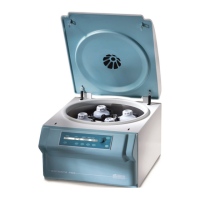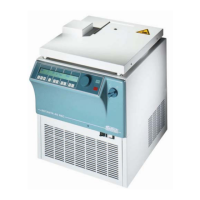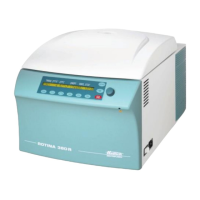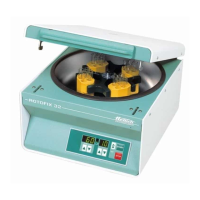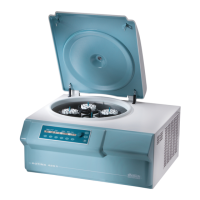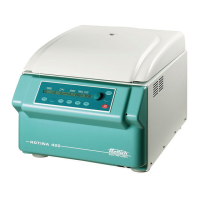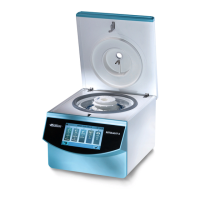Do you have a question about the Hettich ROTANTA 460 Robotic and is the answer not in the manual?
Describes the loading hatch and rotor positioning mechanism.
Details different operating modes for the centrifuge.
Clarifies the difference between Generation 1 and Generation 2 communication protocols.
Specifies serial interface parameters: baud rate, data bits, parity, stop bit.
Explanation of control characters (STX, ETX, ENQ) and abbreviations used.
Details the format of an ENQUIRY telegram for data requests.
Details the format of a SELECT telegram for data transmission or commands.
Explains ADR, C, V parameters and hexadecimal character transmission.
Describes the response time for ENQUIRY telegrams and centrifuge reaction.
Describes the response time for SELECT telegrams and centrifuge reaction.
Provides guidance on optimal timing for serial communication requests.
Illustrates an ENQUIRY telegram to retrieve the actual rotor speed.
Illustrates a SELECT telegram to set the rotor speed.
Assigning unique addresses to centrifuges and managing them via the control panel.
Method to detect Generation 2 centrifuges using a specific ENQUIRY telegram.
Information on acknowledging and executing positioning and hatch commands.
Using LOCK 5 to disable the START key, impacting control panel operations.
Comprehensive overview of parameters, their function, compatibility, and access.
Brief introduction to positioning parameters, detailed in chapter 2.10.
In-depth explanation of various parameters, their structure, and usage.
Covers features like software lock, value validity checking, and limitations.
Describes the centrifuge state and required ENQUIRY protocol after power on.
Step-by-step guide for opening the hatch using serial commands.
Step-by-step guide for closing the hatch using serial commands.
Procedure for setting a specific rotor position via serial commands.
Procedure for initiating centrifugation using serial commands and checks.
Procedure for stopping centrifugation using serial commands.
Methods for saving and loading centrifuge programs via serial interface.
Example of serial commands executed after initiating PC communication.
Example of cyclic serial queries during standstill and positioning.
Procedure for changing operational parameters via serial interface.
Steps for a PC to write and store a program in the centrifuge memory.
Steps for a PC to recall and activate a stored program.
Detailed example of serial commands for opening the centrifuge hatch.
Detailed example of serial commands for setting rotor position 1.
Detailed example of serial commands for setting rotor position 4.
Detailed example of serial commands for closing the centrifuge hatch.
Detailed example of serial commands to recall program number 6.
Detailed example of serial commands to start centrifugation.
Detailed example of serial commands to stop centrifugation.
Examples for waiting for standstill, auto-position 1, and terminating positioning.
Highlights that serial protocol, settings, and telegrams are constant across generations.
Summarizes differences in parameters and hardware features between Gen 1 and Gen 2.
Table comparing parameters for Gen 1 and Gen 2, including access types.
Example of opening the hatch using commands compatible with Generation 1.
Example of moving to position 1 and checking its status, compatible with Gen 1.
Example of moving to position 2 and checking its status, compatible with Gen 1.
Example of moving to position 3 and checking its status, compatible with Gen 1.
Example of moving to position 4 and checking its status, compatible with Gen 1.
Example of closing the hatch using commands compatible with Generation 1.
Example of starting the centrifuge using commands compatible with Generation 1.
Command to initiate an emergency stop via PC communication.
Procedure to cancel software locks (LOCK 4 or LOCK 5) via serial commands.
Changing operational values via serial commands, compatible with Gen 1.
Recalling a stored program via serial commands, compatible with Gen 1.
Changing and storing program values via serial commands, compatible with Gen 1.
Describes the loading hatch and rotor positioning mechanism.
Details different operating modes for the centrifuge.
Clarifies the difference between Generation 1 and Generation 2 communication protocols.
Specifies serial interface parameters: baud rate, data bits, parity, stop bit.
Explanation of control characters (STX, ETX, ENQ) and abbreviations used.
Details the format of an ENQUIRY telegram for data requests.
Details the format of a SELECT telegram for data transmission or commands.
Explains ADR, C, V parameters and hexadecimal character transmission.
Describes the response time for ENQUIRY telegrams and centrifuge reaction.
Describes the response time for SELECT telegrams and centrifuge reaction.
Provides guidance on optimal timing for serial communication requests.
Illustrates an ENQUIRY telegram to retrieve the actual rotor speed.
Illustrates a SELECT telegram to set the rotor speed.
Assigning unique addresses to centrifuges and managing them via the control panel.
Method to detect Generation 2 centrifuges using a specific ENQUIRY telegram.
Information on acknowledging and executing positioning and hatch commands.
Using LOCK 5 to disable the START key, impacting control panel operations.
Comprehensive overview of parameters, their function, compatibility, and access.
Brief introduction to positioning parameters, detailed in chapter 2.10.
In-depth explanation of various parameters, their structure, and usage.
Covers features like software lock, value validity checking, and limitations.
Describes the centrifuge state and required ENQUIRY protocol after power on.
Step-by-step guide for opening the hatch using serial commands.
Step-by-step guide for closing the hatch using serial commands.
Procedure for setting a specific rotor position via serial commands.
Procedure for initiating centrifugation using serial commands and checks.
Procedure for stopping centrifugation using serial commands.
Methods for saving and loading centrifuge programs via serial interface.
Example of serial commands executed after initiating PC communication.
Example of cyclic serial queries during standstill and positioning.
Procedure for changing operational parameters via serial interface.
Steps for a PC to write and store a program in the centrifuge memory.
Steps for a PC to recall and activate a stored program.
Detailed example of serial commands for opening the centrifuge hatch.
Detailed example of serial commands for setting rotor position 1.
Detailed example of serial commands for setting rotor position 4.
Detailed example of serial commands for closing the centrifuge hatch.
Detailed example of serial commands to recall program number 6.
Detailed example of serial commands to start centrifugation.
Detailed example of serial commands to stop centrifugation.
Examples for waiting for standstill, auto-position 1, and terminating positioning.
Highlights that serial protocol, settings, and telegrams are constant across generations.
Summarizes differences in parameters and hardware features between Gen 1 and Gen 2.
Table comparing parameters for Gen 1 and Gen 2, including access types.
Example of opening the hatch using commands compatible with Generation 1.
Example of moving to position 1 and checking its status, compatible with Gen 1.
Example of moving to position 2 and checking its status, compatible with Gen 1.
Example of moving to position 3 and checking its status, compatible with Gen 1.
Example of moving to position 4 and checking its status, compatible with Gen 1.
Example of closing the hatch using commands compatible with Generation 1.
Example of starting the centrifuge using commands compatible with Generation 1.
Command to initiate an emergency stop via PC communication.
Procedure to cancel software locks (LOCK 4 or LOCK 5) via serial commands.
Changing operational values via serial commands, compatible with Gen 1.
Recalling a stored program via serial commands, compatible with Gen 1.
Changing and storing program values via serial commands, compatible with Gen 1.
| Type | Centrifuge |
|---|---|
| Max Speed | 15, 000 RPM |
| Max RCF | 24, 400 x g |
| Capacity | 4 x 750 ml |
| Temperature Range | -20°C to +40°C |
| Power Supply | 230 V, 50/60 Hz |
| Robot-compatible | Yes |
| Timer | 1 - 99 min, continuous operation |
| Noise level | <60 dB |
